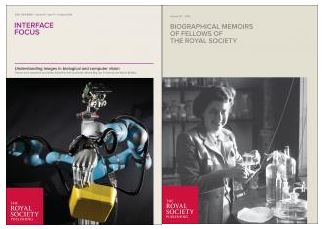Have you ever thought about what goes into making a great journal cover? Here we explore how our journals select cover images and provide some tips to authors aspiring to have their work featured on the cover.


As you know, we aim to give our readers the best content to read in each and every issue. The authors of our articles have often talked about their experiences of publishing with us, but what hasn’t been talked about as much are the images we feature on the cover of each journal issue, highlighting the research inside.
We try to feature the best covers from the stunning pictures our authors often provide. In fact, it was because of the high-quality images we received that inspired us to launch the Royal Society Publishing Photography Competition in 2015.
Have you ever thought what makes a good cover image? Why are some pictures chosen over others sent in to us? We asked the Publishing team for their tips, which we share with you now…

- Firstly, it’s really important that your image is of a high quality. We don’t have any requirements on pixel size but as most of the journals are printed, the image you have should be able to look clear in print as well as online. If you zoom halfway into your picture, do things become a little blurry? If so, it may not be appropriate for the cover.
- Make sure your image is suitable for the journal you have published your article in. This should be easy enough, as the image would have probably been taken from the research article you have just had accepted. However, it’s worth taking a quick look at what the journal has already featured on the cover, as each has its own identity and style. For example, the Journal of the Royal Society Interface will often have abstract cover images, reflecting the biological and physical nature of the content they publish. Notes and Records will feature historical images, perhaps from the Royal Society’s own archives. Open Biology will have a molecular focus, while Royal Society Open Science will alternate having images from the physical and biological sciences.
- When it comes to choosing between different images, the team will likely go for something that hasn’t been shown recently or is the more memorable image. This can be quite subjective but is one reason why a particular picture is chosen over another.

- Like a lot of other things, timing is important. The journal teams have to choose a cover a few days in advance of the new issue opening. Sending a cover image when you are submitting your revised manuscript will keep this in our minds when it comes to making this decision.
- It doesn’t matter where in the world you are from. Just as anyone can submit to our journals, any author can send an image for the front cover. We try to feature a cover image from a paper published in the same issue but this isn’t a hard and fast rule. Indeed, an image can feature in any issue.
- It may be worth thinking about an image while you are conducting your research. Even if your image isn’t suitable for the cover , we can still use it to promote your article on social media to increase impact so it is always worth sending us your images. You could also submit to the Royal Society Publishing Photography Competition, so there is always a way to showcase your work!
- If you are chosen to have your image on the cover (congratulations!), make sure you provide a caption and the name of the person who should be credited for the image. Having permission to use the image is hugely important, so get this before you even send in a picture.

Do you have any other ideas? Perhaps you’re an author whose image has featured on a journal cover and have some tips to share. Send us your thoughts on what makes a good cover, and we look forward to sharing our covers from 2019 with you soon…
Visit the journal websites to see examples of all our covers from previous issues.
